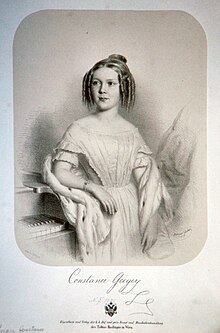Constanze Geiger

Constanze Therese Adelheit Geiger , also Konstanze Geiger , later Constanze Geiger von Ruttenstein , ( October 16, 1835 in Vienna - August 24, 1890 in Bad Dieppe ) was an Austrian pianist , child actress , stage actress , composer and singer ( soprano ).
Life
Geiger, the daughter of the composer Joseph Geiger and the court modist Theresia Geiger geb. Rziha (1804–1865), inherited her father's musical talent, which made itself felt at an early age. After she had received piano lessons from him and JW Tomaschek and Simon Sechter , she tried herself successfully as a concert pianist at the age of 6 [!]. At the age of 13, she took the stage in 1848. She never accepted a permanent engagement, but only made short or long guest appearances.
The "Elisabethen-Wedding March", composed by Constanze Geiger at the age of only 18, was heard for the first time on April 21, 1854 when Duchess Elisabeth arrived in Bavaria, the future Empress Elisabeth of Austria-Hungary , in Nussdorf on the way to her wedding. which took place two days later in Vienna .
On April 23, 1862, she married Prince Leopold of Saxe-Coburg and Gotha and with this morganatic marriage was raised to the status of baron. With the wedding, she withdrew from the stage completely and lived with her family at Radmeric Castle. Her compositions for chamber and church music were still performed. After the death of her husband, she moved to Paris.
Konstanze Geiger was buried in the Montmartre cemetery.
literature
- Ludwig Eisenberg : Large biographical lexicon of the German stage in the XIX. Century . Verlag von Paul List , Leipzig 1903, p. 310, ( Textarchiv - Internet Archive ).
- Uwe Harten : violinists, family. In: Oesterreichisches Musiklexikon . Online edition, Vienna 2002 ff., ISBN 3-7001-3077-5 ; Print edition: Volume 2, Verlag der Österreichischen Akademie der Wissenschaften, Vienna 2003, ISBN 3-7001-3044-9 .
Web links
- Constanze Geiger at certosaverlag.de
Individual evidence
- ^ Christian Sepp: Ludovika. Sisi's mother and her century. Munich 2019, p. 258.
| personal data | |
|---|---|
| SURNAME | Violinist, Constanze |
| ALTERNATIVE NAMES | Geiger, Constanze Therese Adelheit (full name); Geiger, Konstanze; Geiger von Ruttenstein, Constanze (full name) |
| BRIEF DESCRIPTION | Austrian pianist, child actress, theater actress, composer and singer (soprano) |
| DATE OF BIRTH | October 16, 1835 |
| PLACE OF BIRTH | Vienna |
| DATE OF DEATH | August 24, 1890 |
| Place of death | Bad Dieppe |
